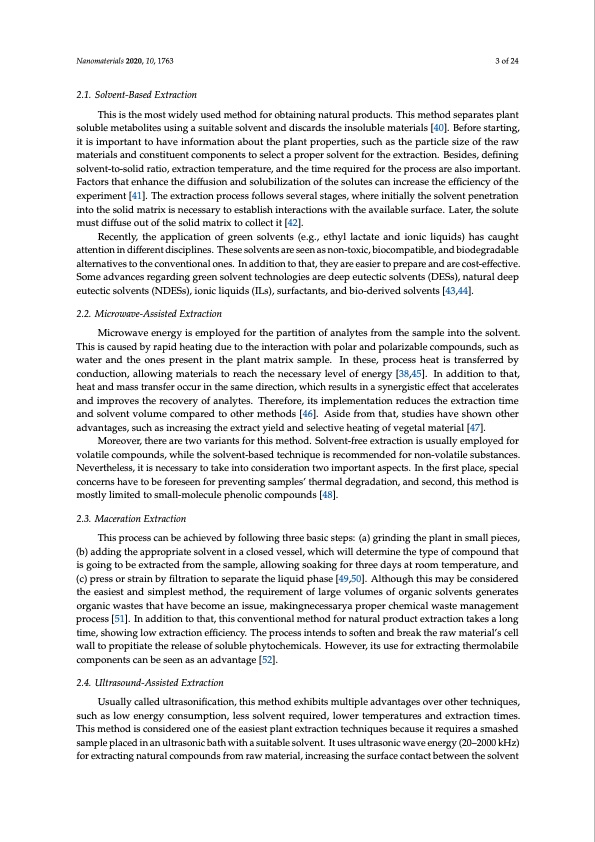
PDF Publication Title:
Text from PDF Page: 003
Nanomaterials 2020, 10, 1763 3 of 24 2.1. Solvent-Based Extraction This is the most widely used method for obtaining natural products. This method separates plant soluble metabolites using a suitable solvent and discards the insoluble materials [40]. Before starting, it is important to have information about the plant properties, such as the particle size of the raw materials and constituent components to select a proper solvent for the extraction. Besides, defining solvent-to-solid ratio, extraction temperature, and the time required for the process are also important. Factors that enhance the diffusion and solubilization of the solutes can increase the efficiency of the experiment [41]. The extraction process follows several stages, where initially the solvent penetration into the solid matrix is necessary to establish interactions with the available surface. Later, the solute must diffuse out of the solid matrix to collect it [42]. Recently, the application of green solvents (e.g., ethyl lactate and ionic liquids) has caught attention in different disciplines. These solvents are seen as non-toxic, biocompatible, and biodegradable alternatives to the conventional ones. In addition to that, they are easier to prepare and are cost-effective. Some advances regarding green solvent technologies are deep eutectic solvents (DESs), natural deep eutectic solvents (NDESs), ionic liquids (ILs), surfactants, and bio-derived solvents [43,44]. 2.2. Microwave-Assisted Extraction Microwave energy is employed for the partition of analytes from the sample into the solvent. This is caused by rapid heating due to the interaction with polar and polarizable compounds, such as water and the ones present in the plant matrix sample. In these, process heat is transferred by conduction, allowing materials to reach the necessary level of energy [38,45]. In addition to that, heat and mass transfer occur in the same direction, which results in a synergistic effect that accelerates and improves the recovery of analytes. Therefore, its implementation reduces the extraction time and solvent volume compared to other methods [46]. Aside from that, studies have shown other advantages, such as increasing the extract yield and selective heating of vegetal material [47]. Moreover, there are two variants for this method. Solvent-free extraction is usually employed for volatile compounds, while the solvent-based technique is recommended for non-volatile substances. Nevertheless, it is necessary to take into consideration two important aspects. In the first place, special concerns have to be foreseen for preventing samples’ thermal degradation, and second, this method is mostly limited to small-molecule phenolic compounds [48]. 2.3. Maceration Extraction This process can be achieved by following three basic steps: (a) grinding the plant in small pieces, (b) adding the appropriate solvent in a closed vessel, which will determine the type of compound that is going to be extracted from the sample, allowing soaking for three days at room temperature, and (c) press or strain by filtration to separate the liquid phase [49,50]. Although this may be considered the easiest and simplest method, the requirement of large volumes of organic solvents generates organic wastes that have become an issue, makingnecessarya proper chemical waste management process [51]. In addition to that, this conventional method for natural product extraction takes a long time, showing low extraction efficiency. The process intends to soften and break the raw material’s cell wall to propitiate the release of soluble phytochemicals. However, its use for extracting thermolabile components can be seen as an advantage [52]. 2.4. Ultrasound-Assisted Extraction Usually called ultrasonification, this method exhibits multiple advantages over other techniques, such as low energy consumption, less solvent required, lower temperatures and extraction times. This method is considered one of the easiest plant extraction techniques because it requires a smashed sample placed in an ultrasonic bath with a suitable solvent. It uses ultrasonic wave energy (20–2000 kHz) for extracting natural compounds from raw material, increasing the surface contact between the solventPDF Image | Green Synthesis of Gold and Silver Nanoparticles from Plant Extracts

PDF Search Title:
Green Synthesis of Gold and Silver Nanoparticles from Plant ExtractsOriginal File Name Searched:
nanomaterials-10-01763.pdfDIY PDF Search: Google It | Yahoo | Bing
Turbine and System Plans CAD CAM: Special for this month, any plans are $10,000 for complete Cad/Cam blueprints. License is for one build. Try before you buy a production license. More Info
Waste Heat Power Technology: Organic Rankine Cycle uses waste heat to make electricity, shaft horsepower and cooling. More Info
All Turbine and System Products: Infinity Turbine ORD systems, turbine generator sets, build plans and more to use your waste heat from 30C to 100C. More Info
CO2 Phase Change Demonstrator: CO2 goes supercritical at 30 C. This is a experimental platform which you can use to demonstrate phase change with low heat. Includes integration area for small CO2 turbine, static generator, and more. This can also be used for a GTL Gas to Liquids experimental platform. More Info
Introducing the Infinity Turbine Products Infinity Turbine develops and builds systems for making power from waste heat. It also is working on innovative strategies for storing, making, and deploying energy. More Info
Need Strategy? Use our Consulting and analyst services Infinity Turbine LLC is pleased to announce its consulting and analyst services. We have worked in the renewable energy industry as a researcher, developing sales and markets, along with may inventions and innovations. More Info
Made in USA with Global Energy Millennial Web Engine These pages were made with the Global Energy Web PDF Engine using Filemaker (Claris) software.
Infinity Turbine Developing Spinning Disc Reactor SDR or Spinning Disc Reactors reduce processing time for liquid production of Silver Nanoparticles.
| CONTACT TEL: 608-238-6001 Email: greg@infinityturbine.com | RSS | AMP |